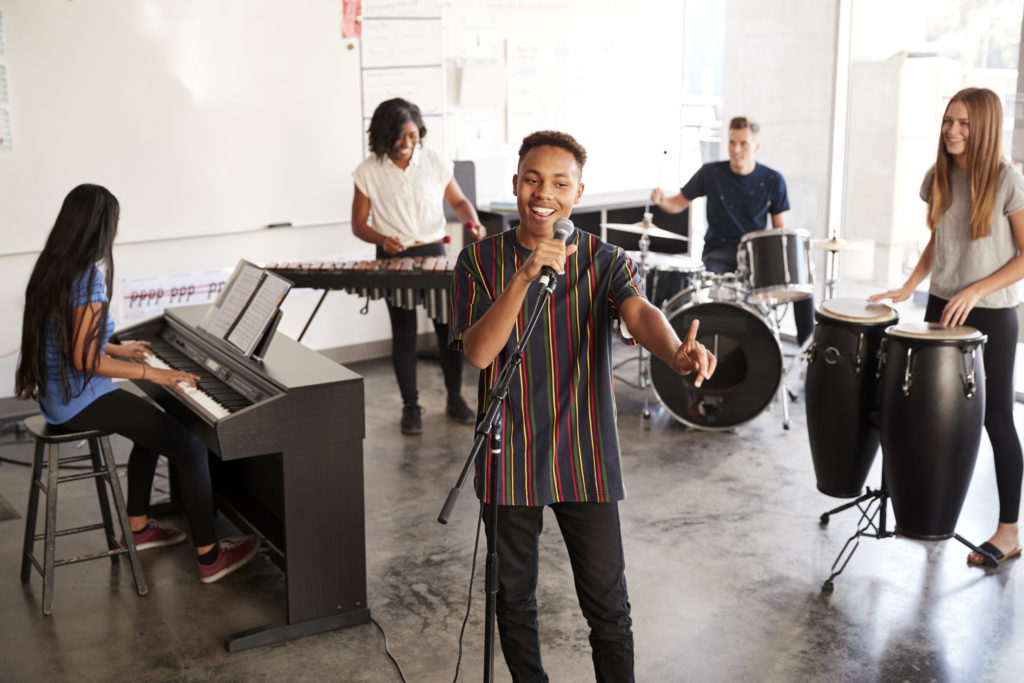Creating Space for Students to Make

Students At Performing Arts School Playing In Band At Rehearsal With Teacher
My work as a teaching artist and arts administrator centers student artmaking. I have not always approached teaching and curriculum through a perspective that maintains the essential role of the teacher as a facilitator of learning and, in the case of arts education, as a facilitator of student art making. This is likely because much of my own education from kindergarten through college consisted of rote learning that focused predominantly on mastery of technical competencies, eschewing imagination, mutuality and generation. Unfortunately this approach, which posits students as passive receptors and empty vessels, still dominates classrooms of every discipline across grade levels.
Though my education in a public school system was robust in its arts curricular requirements and program offerings, I did not often have opportunities or requirements to create music. My identity as a music creator was primarily shaped outside of school by writing songs and playing guitar in a garage band with friends, and through my family’s and community’s celebration of art as innately human and therefore valuable. These formative experiences fostered my belief in the expanded capacity of art as a way of knowing and as a mode of expression and method for building community.
When I first began teaching, I mimicked the education I had received and withheld the same making experiences that were withheld from me. I felt pressure to demonstrate that students learned expeditiously. The simplest way to evaluate that was by teaching easily identifiable and assessable competencies that were commonly understood and testable. This widespread approach fits neatly within the current standards and testing-reliant school systems, but it denies space for artmaking as a modality of knowing and learning.
Reflecting on my own experiences as a student and artist, I came to understand how artmaking and art-experiencing have been essential sense-making and meaning-making processes for me as I’ve navigated learning and life. Recognizing the importance of promoting and supporting students as makers of art, meaning and knowledge in educational environments, I considered how students could be invited and supported to individually and collaboratively create art that examined and/or was derived from their experiences, values and perspectives. Transcending ossified and euro-centric approaches to composition, the students and I began questioning the history and purpose of notation: expanding our thinking around what could be considered notation (text/event scores , graphic scores, game pieces), employing various means for idea generation, engaging with deep listening, improvising collectively (soundpainting, conduction) and incorporating technology (digital audio workstations, notation software, synthesizers, amplification) into the creative process.
Over time, I have embedded a combination of these methods into all of my interactions with students spanning classrooms and residencies, including an elementary school percussion orchestra, instrumental, theory, and composing classes with fourth to 10th grader students and a middle/high school summer camp. I begin with the premise of “student as creator,” often subverting the expectations of students (and adults). Some students engage immediately, the urge to create bursting out of their being; other students require some coaxing and unlearning. Reasonably, there is often hesitation from the fear of vulnerability inherent in making or the skepticism that this type of learning is permissible. Eventually, through consistently listening, improvising, notating, performing and recording activities, we arrive at a place where together we expand the notion of the classroom and deepen our awareness of what can be known with, from and by art. When students (and people of all ages) make original art, not only do they recognize their artistic capacities and identity, they also see themselves as meaning makers, knowledge generators and agents of change.
This post is part of AEP’s Continuing the Arts and Literacies Conversations blog post series. These posts expand on key ideas and topics from our Arts and Literacies Thinkers Meeting Series and from the resulting interactive resource. Through sharing their personal reflections and work experiences, guest authors explore a range of topics that span disciplines, age levels and education environments. You can read the first post in the series here.



